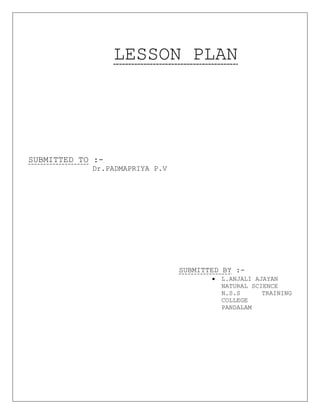Lesson plan anjali
- 1. LESSON PLAN SUBMITTED TO :- Dr.PADMAPRIYA P.V SUBMITTED BY :- ï· L.ANJALI AJAYAN NATURAL SCIENCE N.S.S TRAINING COLLEGE PANDALAM
- 2. CURRICULAR STATEMENT Develops different dimensions of knowledge process skill & attitude on the journey of Oxygen from atmosphere to the tissue through lecture method demonstration, group discussion & evaluation by questioning. CONTENT ANALYSIS NEW TERMS:- FACTS :- MINOR CONCEPT:- MAJOR CONCEPT:- LEARNING OUTCOME:- Blood, alveolus, haemoglobin, Iron, RBC etc. 1) Lungs are full of alveolus. 2) Oxygen diffuses into the alveoli of the lungs. 3) Hemoglobin in the red blood corpuscles absorbs oxygen. 4) There are 50 lakhs of RBC in one ml blood. 5) RBC is disc shaped & do not have a nucleus or other cell organelles, therefore are able to carry more Hb. 6) Iron is the oxygen transporting factor in haemoglobin. 7) Haemoglobin absorbs oxygen & become oxyhaemoglobin. 8) Oxyhaemoglobin is less stable compound. 9) Oxyhaemoglobin dissociates very quickly and provides oxygen to tissue. -Haemoglobin in RBC absorbs oxygen -RBC is disc shaped and have no nucleus or other cell organelles - Iron is the oxygen transporting factor in Hb. -Haemoglobin absorbs oxygen to become oxyhaemoglobin. - Oxyhaemoglobin is less stable & it dissociate into oxygen & haemoglobin when it reach tissue. The pupil, 1) recalls & recognize the structure of alveolus. 2) acquires knowledge in understanding the above mentioned term, facts & concept. 3) understands the structure of RBC & haemoglobin. 4) applies the new knowledge in understanding how oxyhaemoglobin is formed & get dissociates. 5) analyses the process of transport of oxygen to tissue. 6) develops different component of creativity like visualization, process skill like observation, community skill, group discussion. 7) evaluates the flow of oxygen from lungs to tissue through diffusion.
- 3. PRE-REQUISITE:- LEARNING AIDS:- - Structure & function of respiratory organ & alveolus in man. * Chart showing the importance of RBC. * Chart showing the diffusion of oxygen from alveolus to blood vessels. * Activity cards * Text book of class IX SCERT * Chalk board CLASSROOM INTERACTION PROCEDURE Introduction:- Teacher make a rapport with students by asking questions related to content * How exchange of gas take place between alveolus & blood vessels * What is the difference between pulmonary artery & pulmonary vein? To create problematic situation teacher ask following questions. Is there any role of RBC in transport of oxygen from alveolus to tissue? So today we are going to study about the journey of oxygen (C.B) PRESENTATION ACTIVITY- I Teacher show the chart of RBC having its importance & function & ask students to observe the chart & give their answers to the questions after group discussion. EXPECTED PUPIL RESPONSE pupil interact with the teacher Due to concentration difference diffusion occurs. PA- high co2 concentration. PV- high o2 concentration pupil unable to answer pupil observe the chart & give their view points
- 4. RBC Hai! Friends I am RBC. One of my function is to help blood which carry oxygen from lungs to different tissue of the body. For this purpose Hb also helps me. Iam disc shaped & have no nucleus or other cell organelles therefore iam able to carry more haemoglobin. In one ml of blood, 50 lakhs is my population. QUESTIONS * Who carry O2 to different parts of the body? * In RBC which part combines with O2? * What is the shape of RBC? * What important feature in RBC helps to carry more Hb DISSCUSSION POINTS * RBC in blood carries O2 to different parts of the body. * In RBC haemoglobin combine or attract oxygen * RBC is disc shaped (CB) * RBC does not have nucleus or other cell organelles, therefore can carry more Hb. ACTIVITY- II Teacher give activity cards having questions & ask students to give answers through group discussion * What is the oxygen transporting system in haemoglobin? * What happens when haemoglobin combines with oxygen? * What is the concentration of oxygen in blood & tissue? * What type of a compound is pupil give their view points With the help of text book.
- 5. oxyhaemoglobin? Discussion points * Iron is the oxygen transporting factor in hemoglobin. * Oxygen when combines with hemoglobin oxyhaemoglobin is formed (Hbo2). * Concentration of oxygen is higher in blood, so haemoglobin easily combines with O2 to form oxyhaemoglobin, but in tissue concentration of oxygen is less so it easily dissociates into oxygen & haemoglobin * Oxyhaemoglobin is a unstable compound. ACTIVITY-III Teacher shows the chart of journey of oxygen & ask students to discuss in group & write their view points in science diary LUNGS Hb + O2 ------> Hbo2 Hbï ïŊ HbO HbO2 -------> Hb + O2 TISSUES DISCUSSION POINTS In lungs haemoglobin & oxygen combines to form oxyhaemoglobin pupil observe the chart & give their view points
- 6. (HbO2). When HbO2 Reaches tissue it again dissociates into oxygen and haemoglobin due to concentration difference. Oxygen reaches reaches each part of the body & haemoglobin returns to lungs. C.B SUMMARY HbO2 +O2 ----> HbO2 {lungs} RBC- disc shaped HbO2 ----> Hb + O2 {tissue} - no nucleus Fe-O2 transporfactor. Oxyhaemoglobin- less stable REVIEW QUESTIONS * What is the feature of RBC. * Function of haemoglobin in transporting oxygen FOLLOW UP ACTIVITY Draw a flow chart of the journey of oxygen from lungs to tissue and the changes occurring in your science diary.





